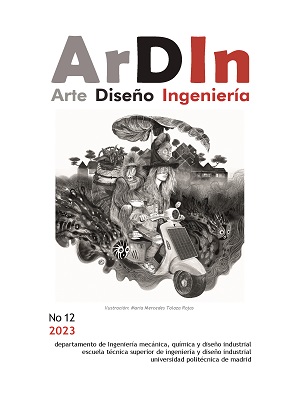Estructuras desplegables aéreas. Casos de estudio y propuesta de refugio = Aerial deployable structures. Case studies and shelter proposal
DOI:
https://doi.org/10.20868/ardin.2023.12.5061Palabras clave:
estructuras, desplegables, 2seconds, Grasshopper, Rhinoceros, deployable, structure,Resumen
Las estructuras desplegables han sido ampliamente utilizadas en el terreno de la arquitectura efímera, más concretamente en el campismo. La aparición en 2003 de la tienda “2seconds” marca un hito en la cultura popular. Este tipo de tiendas se ensamblan por acción de la fuerza de torsión generada en la geometría de sus varillas en el momento del plegado, que se libera en los famosos dos segundos generando un refugio instantáneo. El hecho de que el sistema prescinda de fuentes de energía externas lo hace sostenible, eficiente y fácilmente trasladable. Existen otros ejemplos de experimentación con este tipo de estructuras como el desarrollado por un estudio de arquitectura chino en 2013 o un equipo del MIT en 2017. El presente artículo estudia y compara las geometrías que componen los citados diseños recurriendo al plugin para Rhinoceros, Grasshopper, que permite hacer cambios dimensionales con facilidad sobre un mismo modelo. El fin último de este estudio es, habiendo estudiado el funcionamiento estructural de los distintos sistemas, establecer las pistas para el desarrollo de uno nuevo capaz de funcionar como refugio.
Abstract
Deployable structures have been widely used in the field of ephemeral architecture, more specifically in the countryside. The appearance in 2003 of the store "2seconds" marks a milestone in popular culture. These types of stores are assembled by the action of the torque force generated in the geometry of their rods at the time of folding, which is released in the famous two seconds generating an instant shelter. The fact that the system dispenses with external energy sources makes it sustainable, efficient, and easily transferable. There are other examples of experimentation with this type of structures such as the one developed by a Chinese architecture studio in 2013 or a team from MIT in 2017.
This article studies and compares the geometries that make up the designs using the plugin for Rhinoceros, Grasshopper, which allows making dimensional changes with ease on the same model. The ultimate purpose of this study is, having studied the structural functioning of the different systems, to establish the paths for the development of a new one capable of functioning as a shelter.
Descargas
Referencias
Domínguez Somonte, M., & Espinosa Escudero, M.M. (2013). Ingeniería concurrente. Ed. AIDA-I4, Madrid.
Pop-up Habitat. (2013, junio). People´s Architecture Office. Recuperado 9 de enero de 2022, de http://www.peoples-architecture.com/pao/en/project-detail/21
Historia de la tienda 2seconds. (2018). Quechua. Recuperado 9 de enero de 2022, de http://quechua-tente2014.ores-group.com/es_ES/historia
Rivas-Adrover, E. (2017). Classification of geometry for deployable structures used for innovation: Design of new surfaces with scissor 2 bar, and form generation method of relative ratios. International Journal of Computational Methods and Experimental Measurements. https://doi.org/10.2495/CMEM-V5-N4-464-474
Staback, D., & Addison, J. (2017). Aerial Pop-Up Structures. 582–589.
Descargas
Publicado
Número
Sección
Licencia
- Los autores conservan los derechos de autor y garantizan a la revista el derecho de una Licencia Creative Commons Atribución - Nocomercial 4.0 Internacional (CC BY NC ND) que permite a otros compartir el trabajo con un reconocimiento de la autoría y uso no comercial.
- Los autores pueden establecer por separado acuerdos adicionales para la distribución no exclusiva de la versión de la obra publicada en la revista (por ejemplo, situarlo en un repositorio institucional o publicarlo en un libro).
- Salvo indicación contraria, todos los contenidos de la edición electrónica se distribuyen bajo una licencia de uso y distribución “Creative Commons"













